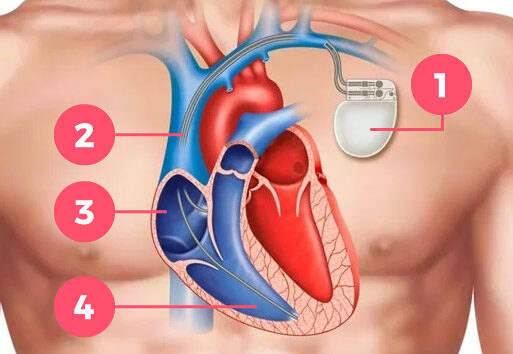The Bundle of His, named after a Swiss physician Wilhelm His, who described the structure in 1893, is like a “wire” that directs the impulses in the heart from the atria to the ventricles.

- Bundle of His
When doctors perform a Bundle of His ablation or His-Bundle Ablation, they destroy the impulse line from the atria to the heart chambers, preventing the heart chambers from functioning correctly. This means that it is necessary to install a pacemaker device in order to control the speed of the patient’s pulse.

- Pacemaker
- Pacemaker-leads
- Right atrium
- Right ventricle
It is important to note that a Bundle of His ablation or His-Bundle Ablatio does not remove or cure atrial fibrillation. However the procedure does mean that the chaotic signals caused by atrial fibrillation no longer affect the heart chamber rhythm, and thus no longer affect the pulse.
This essentially means that your sinus node or your atrial fibrillation no longer regulates your pulse, the pacemaker does instead. Like the sinus node, pacemakers are able to increase or decrease your heart rate depending upon your activity level.
Typically, atrial fibrillation may persist after performing the Bundle of His ablation. This means that you will still require blood-thinning medication.
Many patients experience a significant improvement in their quality of life and well-being after this procedure. A Bundle of His ablation and pacemaker implantation is typically performed if other attempts to treat atrial fibrillation have proven to be ineffective.